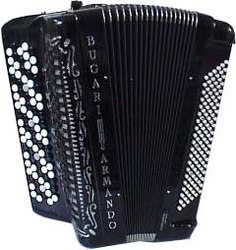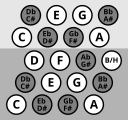
Accordions are a family of box-shaped musical instruments of the bellows-driven free reed aerophone type. The essential characteristic of the accordion is to combine in one instrument a melody section, also called the diskant, usually on the right-hand manual, with an accompaniment or Basso continuo functionality on the left-hand. The musician normally plays the melody on buttons or keys on the right-hand side, and the accompaniment on bass or pre-set chord buttons on the left-hand side. A person who plays the accordion is called an accordionist.

A concertina is a free-reed musical instrument, like the various accordions and the harmonica. It consists of expanding and contracting bellows, with buttons usually on both ends, unlike accordion buttons, which are on the front.

The sheng is a Chinese mouth-blown polyphonic free reed instrument consisting of vertical pipes.

The bandoneon is a type of concertina particularly popular in Argentina and Uruguay. It is a typical instrument in most tango ensembles. As with other members of the concertina family, it is held between the hands, and played by pulling and pushing air through bellows, routing it through sets of tuned metal reeds by pressing the instrument's buttons. Unlike most accordions, bandoneons always employ the same sets of reeds to produce their sound, and do not usually have the register switches common on accordions. Nevertheless, the bandoneon can be played very expressively, using various bellows pressures and other techniques.

A free reed aerophone is a musical instrument that produces sound as air flows past a vibrating reed in a frame. Air pressure is typically generated by breath or with a bellows. In the Hornbostel–Sachs system, it is number: 412.13. Free reed instruments are contrasted with non-free or enclosed reed instruments, where the timbre is fully or partially dependent on the shape of the instrument body, Hornbostel–Sachs number: 42.
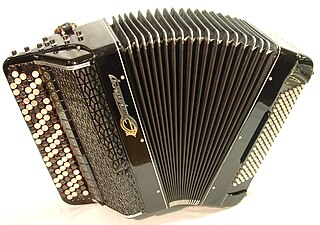
The bayan is a type of chromatic button accordion developed in the Russian Empire in the early 20th century and named after the 11th-century bard Boyan.

A Chemnitzer concertina is a musical instrument of the hand-held bellows-driven free-reed category, sometimes called squeezeboxes. The Chemnitzer concertina is most closely related to the bandoneón, more distantly to the other concertinas, and accordions.

The garmon, commonly called garmoshka, is a kind of Russian button accordion, a free-reed wind instrument. A garmon has two rows of buttons on the right side, which play the notes of a diatonic scale, and at least two rows of buttons on the left side, which play the primary chords in the key of the instrument as well as its relative harmonic minor key. Many instruments have additional right-hand buttons with useful accidental notes, additional left-hand chords for playing in related keys, and a row of free-bass buttons, to facilitate playing of bass melodies. The term "Garmon" means overcomer, winner or "noble" believed epistemologically to derive from the term for "blue" which nobility wore. It is believed perhaps Russian aristocratic, tzars and or royal leadership had garmons played in their courts.

A button accordion is a type of accordion on which the melody-side keyboard consists of a series of buttons. This differs from the piano accordion, which has piano-style keys. Erich von Hornbostel and Curt Sachs categorize it as a free reed aerophone in their classification of instruments, published in 1914. The sound from the instrument is produced by the vibration of air in reeds. Button accordions of various types are particularly common in European countries and countries where European people settled. The button accordion is often confused with the concertina; the button accordion's buttons are on the front of the instrument, where as the concertina's are on the sides and pushed in parallel with the bellows.

A piano accordion is an accordion equipped with a right-hand keyboard similar to a piano or organ. Its acoustic mechanism is more that of an organ than a piano, as they are both aerophones, but the term "piano accordion"—coined by Guido Deiro in 1910—has remained the popular name. It may be equipped with any of the available systems for the left-hand manual.

The Flutina is an early precursor to the diatonic button accordion, having one or two rows of treble buttons, which are configured to have the tonic of the scale, on the "draw" of the bellows. There is usually no bass keyboard: the left hand operates an air valve. A rocker switch, called a "bascule d'harmonie" is in the front of the keyboard. When this switch is thumb activated, it would open up a pallet (a pad that covers a tone hole, at the other end of the key button, for a simple Tonic/Dominant drone: Tonic on the draw and Dominant on the press, e.g. Tonic notes C/g, and Dominant G/d, without any major or minor thirds.

A melodeon or diatonic button accordion is a member of the free-reed aerophone family of musical instruments. It is a type of button accordion on which the melody-side keyboard contains one or more rows of buttons, with each row producing the notes of a single diatonic scale. The buttons on the bass-side keyboard are most commonly arranged in pairs, with one button of a pair sounding the fundamental of a chord and the other the corresponding major triad.
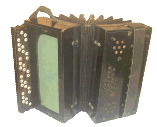
A Schrammel accordion is an accordion with a melody keyboard in the chromatic B-Griff system and a twelve-button diatonic bass keyboard. It is named for a traditional combination of two violins, accordion or clarinet, and contraguitar known as a Schrammelquartet – a group that played Schrammelmusik in the Vienna chamber music tradition.
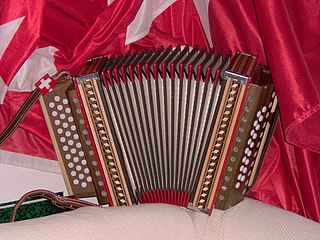
The Schwyzerörgeli is a type of diatonic button accordion used in Swiss folk music. The name derives from the town/canton of Schwyz where it was developed. Örgeli is the diminutive form of the word Orgel (organ). Outside of Switzerland the instrument is not well known and is hard to find.

The Stradella Bass System is a buttonboard layout equipped on the bass side of many accordions, which uses columns of buttons arranged in a circle of fifths; this places the principal major chords of a key in three adjacent columns.

A free-bass system is a system of left-hand bass buttons on an accordion, arranged to give the performer greater ability to play melodies with the left-hand and form one's own chords. The left-hand buttonboard consists of single-note buttons with a range of three octaves or more, in contrast to the standard Stradella bass system, which offers a shorter range of single bass notes, plus preset major, minor, dominant seventh, and diminished chord buttons. The term "free-bass system" refers to various left-hand manual systems that provide this functionality: The Stradella system does not have buttons for different octaves of the bass notes, which limits the types of melodies and basslines that can be performed with the left hand.
The accordion is in a wide variety of musical genres, mainly in traditional and popular music. In some regions, such as Europe and North America, it has become mainly restricted to traditional, folk and ethnic music. In other regions such as Mexico, the instrument is very popular in genres like Norteño, and in Brazil, it is a fixture in popular music styles as Sertanejo and Forró.

The Steirische Harmonika is a type of bisonoric diatonic button accordion important to the alpine folk music of Croatia, Slovenia, the Czech Republic, Austria, the German state of Bavaria, and the Italian South Tyrol. The Steirische Harmonika is distinguished from other diatonic button accordions by its typically richer bass notes, and by the presence of one key per scale row that has the same tone on both compression and expansion of the bellows, called a Gleichton. The bass notes earn the distinction Helikonbässe because they use bigger reeds with duralumin reed frames and a special chamber construction that amplifies its bass tones to give it a loud sound reminiscent of a Helicon tuba.

Khromka is a type of Russian garmon. It is the most widespread variant in Russia and in the former USSR. Nearly all Russian garmons made since the mid of the 20th century are khromkas.

The Anglo or Anglo-German concertina is a member of the concertina family of free-reed instruments.
